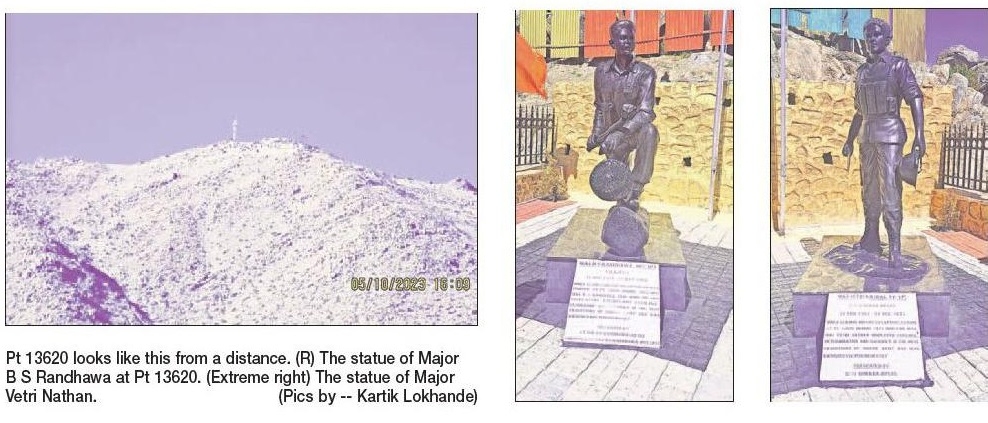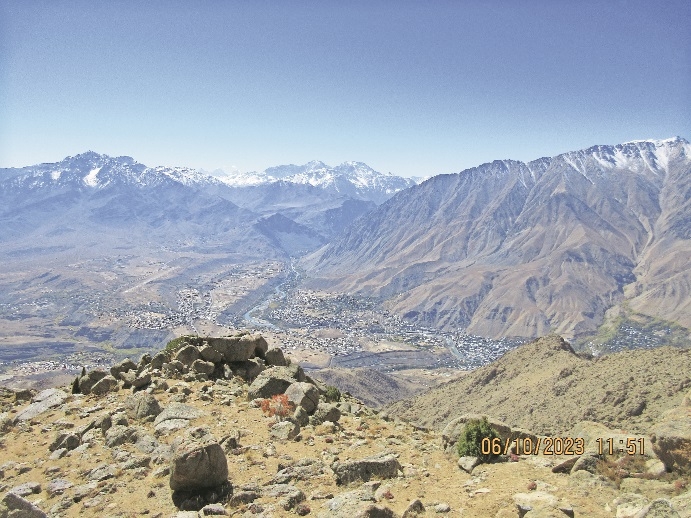Unique tale of Pt 13620 Taken, handed back. Taken, handed back. Finally, taken in 1971
| Date :03-Nov-2023 |

By Kartik Lokhande:
Today, Pt 13620 proudly stands as a testimonial of the Indian Army’s saga of valour in all four battles fought against Pakistan till date. The gain of
Pt 13620 during 1971 war thus proved to be
beneficial for
India during
1999 conflict.
IF THERE is one classic example of how the bravery of soldiers including the supreme sacrifices is done away with at the political negotiating tables, it is of Pt 13620. This particular feature is very crucial as it overlooks the town of Kargil. It has seen four wars with Pakistan -- 1947-48, 1965, 1971, and 1999. However, before 1971, it was captured and recaptured by valiant Indian forces, but had to be returned to Pakistan! Read on, to know more.
The Indian national tricolour flying high atop a mountain around Kargil town, cannot
miss the careful eye. At night, the lights on this high mountain catch the eye from Kargil town on the banks of Suru river below. A little enquiry and one gets to know that this prominent and crucial feature is Pt 13620, which is actually at an altitude of over 14,000 feet. Like other features of crucial significance, it also has a story to be told. But, its story is a bit unique and has bravery, politics, and the United Nations intervention woven together.

The Pt 13620 overlooks the National Highway connecting Srinagar and Leh. The feature was illegally occupied by Pakistan Army in 1947-48. After several hard-fought battles and a lot of effort and ingenuity, the Indian forces were able to thwart Pakistan’s designs in 1947-48 to occupy the State of Jammu and Kashmir. The Indian forces successfully broke through Zojila pass, advanced to Drass, Kargil, and then established linkup with Leh. However, in the spirit of Karachi agreement of 1949, Pakistan retained the capability to dominate NH1A and Kargil town by virtue of occupying Pt 13620, the highest feature overlooking Kargil. In 1965, Pakistan attempted another military misadventure to annex Jammu and Kashmir as part of its overall plan to exert pressure on the United Nations (UN). It planned to cut off the crucial and slender communication to Ladakh region. From Pt 13620, Pakistan continued to enhance its interference on NH1A. For the Indian forces, Kargil Sector turned out to be an unacceptable nuisance because of Pakistan dominating this feature.
Though not one dedicated account is available in public domain regarding Pt 13620, information is available in a scattered manner. As per one account, the continued interference by Pakistan by virtue of holding Pt 13620 and dominating Kargil and National Highway connecting Srinagar and Leh, forced 4 Rajput Brigade to undertake elimination of enemy posts overlooking the highway and Kargil town. The 4 Rajput launched an attack and captured Pt 13620, Black Rock, and Camel’s Back on May 16/17, 1965. The operation that commenced at 2 am on May 17 left the enemy completely surprised. The B Company pounced on the enemy, resulting in hand to hand fighting. The company regrouped and neutralised the remaining resistance there. By 3.30 am, Pt 13620 was captured. However, in the action, a young Major B S Randhawa, who was awarded Maha Vir Chakra (MVC) posthumously, made the supreme sacrifice. Born on November 11, 1934, Major B S Randhawa made the supreme sacrifice at the age of less than 31 years. The enemy, being at an advantageous height, gave an intense fight.
However, it did not budge Major B S Randhawa. Despite being seriously injured, he refused to be evacuated and kept encouraging his men. The men with renewed vigour continued the attack and captured Pt 13620. In the present day, there is a statue of Major B S Randhawa. A citation states that while leading his company to capture the enemy held position at Pt 13620 on May 17, 1965, he laid down his life displaying exemplary courage, leadership, and sacrifice in the best traditions of Indian Army. His statue was presented to the post by Lt Colonel R S Randhawa (Retd), brother of Major B S Randhawa. An adjoining feature is now named as Randhawa Spur in the honour of the braveheart. Unfortunately, despite the point being captured after great sacrifice, Pt 13620 was handed back to Pakistan due to the UN intervention. Obviously, Pakistan continued giving trouble to Indian forces from that height. In June, the Indian Army again wrested the post back from Pakistan.
The 1 Guards and J&K Militia, in a valiant attack on June 6, 1965, not only captured Kala Pahar and Snow Peak features respectively but also pushed the enemy further north. Again, consequent to the UN intervention branding the Indian action as violation of ceasefire, Pt 13620 had to be restored to Pakistan on June 29, 1965. By the first week of August 1965, Pakistan again resorted to mass infiltration into Jammu and Kashmir under another misadventure codenamed ‘Operation Gibraltar’. It tasked Tariq Force to infiltrate into Kargil Sector and fan out towards Drass, Zojila, Kargil, Batalik, Budhkharbu, and Zanskar region. The alert Indian forces detected it early. However, the early detection also called for an immediate sealing of ingress and exit routes. To achieve this, it became essential for India to recapture of Pt 13620, Saddle, and Black Rock areas. So, 17 Punjab was tasked to recapture Pt 13620 Complex. The operation commenced as scheduled on August 15, and by 4 am, the feature was successfully recaptured. It was a gift to the nation celebrating 19th Independence Day. However, once again, negotiations failed the gains achieved by the valiant soldiers. After the 1965 war (the full-scale 1965 war is said to have started from September 1), ceasefire was ordered.
The Tashkent Agreement was signed to not alter the territories. With the Tashkent Agreement coming into force during the year 1966, Pt 13620 was again handed back to Pakistan! This saga of capturing and returning the crucial post and the sword of enemy trouble dangling over Kargil town and Srinagar-Leh highway, had to be broken. The year 1971 brought that opportunity. During 1971 war, though much of the action was concentrated on the borders of what was known as East Pakistan (later liberated as Bangladesh), the Indian Army planned an offensive to recapture Pt 13620 to have better security and lend additional depth to NH1A. The attack was launched on December 5, 1971. Accordingly, 2/11 Gorkha Rifles launched a fierce attack and recaptured Pt 13620 and surrounding peaks by 1 pm on December 9, 1971.
However, the action cost life of another young officer. Major Vetri Nathan, awarded Vir Chakra posthumously, was leading his company to capture the enemy position at Pt 13620. The fight was intense, but with his indomitable spirit, he led the team successfully despite the inclement weather and challenges. He not only displayed courage and determination, but also made the supreme sacrifice in service of motherland. Born on February 24, 1941, Major Vetri Nathan was less than 30 years of age when he made the supreme sacrifice. Today, apart from the statue of Major B S Randhawa, Pt 13620 has the statue of Major Vetri Nathan too. The statue of Major Vetri Nathan has a ‘kukri’ in one hand and helmet in the other. Both the statues stand tall under the 75-feet high flag-post on which flies the Indian national tricolour. A nearby feature is named after Major Vetri Nathan in honour of his bravery. Thankfully, since 1971, Pt 13620 has remained with the Indian Army in Kargil Sector. The significance of this crucial point can be understood from the fact that during the 1999 conflict, Pakistan could not interfere much with the Indian transport in this particular area, albeit it occupied other high posts with an intention to cut off Srinagar-Leh highway again.
Today, Pt 13620 proudly stands as a testimonial of the Indian Army’s saga of valour in all four battles fought against Pakistan till date. From the point, one can get a breathtaking view of the Kargil town below on one side, and on the other side of the mountain one can see the Pakistan occupied territory. The gain of Pt 13620 during the 1971 war thus proved to be beneficial for India during 1999 conflict in this area. Of course, this was not the only post taken during 1971 war in Ladakh region. Though the actual number may not be known, as alteration in territory held takes place during the heat of war, one more example is available in public domain. It is a village... (To be continued)